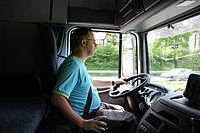
Photo from wikipedia
Abstract When analyzing the causes of an accident, it is critical to determine whether the driver could have prevented the accident. In previous studies on the reaction times of drivers,… Click to show full abstract
Abstract When analyzing the causes of an accident, it is critical to determine whether the driver could have prevented the accident. In previous studies on the reaction times of drivers, the definition and values of reaction times vary, so applying reaction time is difficult. In such analysis, the driver’s reaction time from perception is required to determine whether the driver could have prevented the accident, but past studies are difficult to utilize in accident analysis as reaction time measurements were taken after the occurrence of hazardous situations. In this study, 93 subjects from age groups ranging from 20 s to 40 s participated in an experiment inside a full-scale driving simulator, to determine reaction time values that can be practically applied to accident analysis. A total of 4 hazardous accident situations were reproduced, including driving over the centerline, pedestrian jaywalking, a vehicle cutting in, and intersection traffic signal violation. The Time-To-Collision (TTC) was 2.5 s and the driving speed was set to the common city road speed limits of 60 and 80 km/h. An eye tracker was used to determine the driver’s Saccade Latency (SL) during hazardous situations. Brake Reaction Time from Perception (BRTP), Steer Reaction Time from Perception (SRTP), and Driver Reaction Time from Perception (DRTP) were derived, and the measurements were statistically analyzed to investigate differences by age group, gender, speed, and type of hazardous situation. Most participants were found to avoid collisions by braking first rather than steering for the presented hazardous situations, except for the cutting in situation. Also, to determine a reaction time that would cover most drivers, the 85th percentile of DRTP was calculated. The 85th percentile of DRTP was in the range of 0.550 – 0.800 s. Specifically for each hazardous situation, it was 0.650 s for driving over the centerline, 0.800 s for the pedestrian jaywalking, 0.660 s for cutting in, and 0.550 s for the intersection traffic signal violation. For all 4 hazardous situations combined, the 85th percentile of DRTP was 0.646 s. The findings can be utilized to determine the driver’s likelihood of avoiding accidents when faced with similar hazardous situations.
Journal Title: Transportation Research Part F: Traffic Psychology and Behaviour
Year Published: 2021
Link to full text (if available)
Share on Social Media: Sign Up to like & get
recommendations!